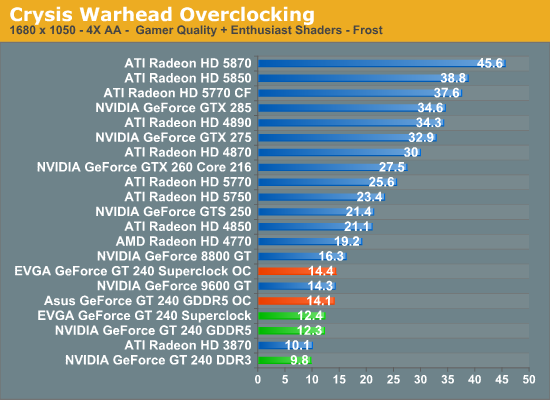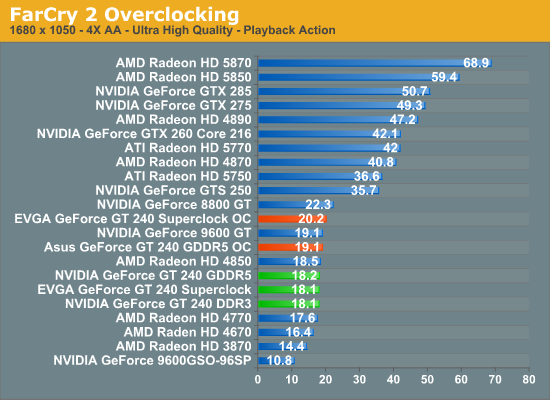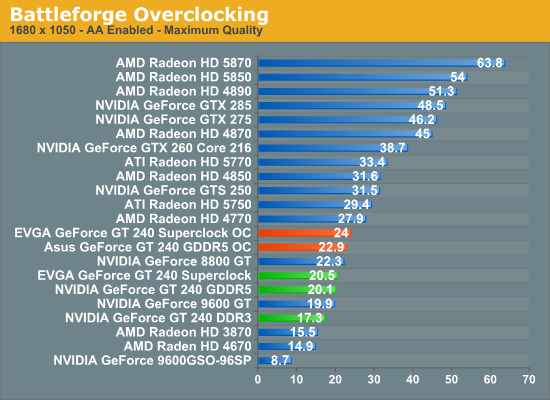NVIDIA’s GeForce GT 240: The Card That Doesn't Matter
by Ryan Smith on January 6, 2010 12:00 AM EST- Posted in
- GPUs
Overclocking
As we briefly mentioned in the introduction, the GT 240 has a 70W TDP, one we believe to be chosen specifically to get as much out of the card as possible without breaking the 75W limit of a PCIe slot. Based on the lower core and shader clock speeds of the GT 240 compared to the GT 220 (not to mention the 8800 GT) we believe it to be a reasonable assumption that the GPU is capable of a great deal more, so long as you’re willing to throw the 75W limit out the window.
There’s also the matter of the RAM. The DDR3 card is a lost cause anyhow thanks to its low performance and the fact that it’s only 10MHz below its RAM’s rated limit, but the GDDR5 cards have great potential. The Samsung chips on those cards are rated for 4000MHz effective, some 17% more than the stock speed of 3400MHz effective. If the memory bus can hold up, then that’s a freebie overclock.
So with that in mind, we took to overclocking our two GDDR5 cards: The Asus GT 240 512MB GDDR5, and the EVGA GT 240 512MB GDDR5 Superclocked.
For the Asus card, we managed to bring it to 640MHz core, 4000MHz RAM, and 1475MHz shader clock. This is an improvement of 16%, 17%, and 10% respectively. We believe that this card is actually capable of more, but we have encountered an interesting quirk with it.
When we attempt to define custom clock speeds on it, our watt meter shows the power usage of our test rig dropping by a few watts, which under normal circumstances doesn’t make any sense. We suspect that the voltage on the GPU core is being reduced when the card is overclocked, however there’s currently no way to read the GPU voltage of a GT 240, so we can’t confirm this. However it does fit all of our data, and makes even more sense once we look at the EVGA card.
For the EVGA card, we managed to bring it to 650MHz core, 4000MHz RAM, and 1700MHz shader clock. This is an improvement of 18%, 11%, and 27% respectively.
Compared to our Asus card, we do not get any anomalous power readings when attempting to overclock it, so if our GPU core voltage theory is correct, then this would explain why the two cards overclocked so differently. In any case, the significant shader overclocking should be quite beneficial in what shader-bound situations exist for the GT 240.

Crysis gives us some very interesting results when overclocked, and this data helps cement the idea that Crysis is ROP-bound on the GT 240. Compared to a stock GT 240, our overclocked Asus and EVGA cards get roughly 15% and 17% more performance. More interestingly, they’re only a few tenths of a frame apart, even though the EVGA card has its shaders clocked significantly higher.
As the performance difference almost perfectly matches the core overclock, this makes Crysis an excellent candidate for proving that the GT 240 can be ROP-bound. It’s a shame that the GT 240’s core doesn’t overclock more than the shaders, as given the ROP weakness we’d rather have more core clockspeed than shader clockspeed in our overclocking efforts.

When it comes to Far Cry 2, the significant shader speed differences finally make themselves more apparent. Our cards are still suffering from RAM limitations, but it’s still enough to get another 10% out of the EVGA card.

Finally with Battleforge we can see a full stratification of results. The overclocked EVGA card is some 19% faster than a stock GT 240, and 5% faster than the overclocked Asus. Meanwhile the Asus is 14% faster than stock, even with its more limited shader overclock.
Finally, on a quick note we’ll talk about power usage. As we mentioned previously only the EVGA card behaved correctly when overclocking – in overclocking that card we saw a 21W jump from 172W under load to 193W under load. If indeed that card is at or close to 70W under normal circumstances as NVIDIA’s specifications call for, then when overclocked it’s over 90W. It becomes readily apparent here that the clock speeds of the GT 240 were picked by NVIDIA to meet the PCIe power limit rather than the capabilities of the GPU itself.










55 Comments
View All Comments
Natfly - Wednesday, January 6, 2010 - link
It also makes absolutely no sense that they compare it to the 9600GT in every performance benchmark and then completely leave it out in the power/noise benchmarks. WTF is this garbage?gayannr - Wednesday, January 6, 2010 - link
Another good review Anandtech, keep up the good work,btw, pics look blurry ? single handed job ? :D
mariush - Wednesday, January 6, 2010 - link
You'll also find this card as nVidia GTS360M:http://www.semiaccurate.com/2009/12/29/nvidia-gts3...">http://www.semiaccurate.com/2009/12/29/nvidia-gts3...
As usual, renaming king at its best.
techadd - Monday, January 11, 2010 - link
This card is the best bang for the buck right now. The review did not compare the card to the competition. The card supports CUDA and can accelerate a number of applications - from playing dvds to CAD and video editing. All in all this was a disappointing review probably payed by a known monopoly which competes with nVidia.selo - Wednesday, July 7, 2010 - link
I have buyed this card in the begining of 2010 the card was in the box new from a guy on ebay for 70$ and at this price it beats all the cards .If i had to buy it again i buyt at 70$ the card is small has new 40nm gpu and it overclock very easy and the power never goes above 70W in idle is only 20w.Don`t make this mistake again every card matteer for the right price :D